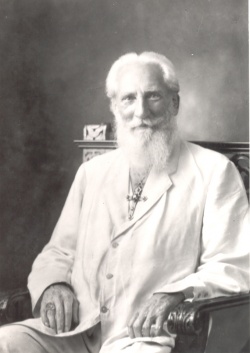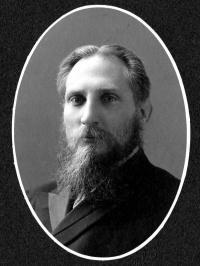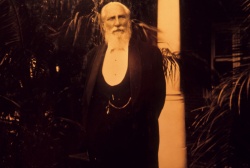Charles Webster Leadbeater: Difference between revisions
Pablo Sender (talk | contribs) No edit summary |
Pablo Sender (talk | contribs) No edit summary |
||
| Line 4: | Line 4: | ||
<br> | <br> | ||
[[File:CW Leadbeater 1.jpg|250px|right|thumb|Charles W. Leadbeater]] | [[File:CW Leadbeater 1.jpg|250px|right|thumb|Charles W. Leadbeater]] | ||
'''Charles Webster Leadbeater''' was an English Theosophist best known for his writings, his clairvoyant observations, and his involvement in the early life of [[Jiddu Krishnamurti]]. | '''Charles Webster Leadbeater''' was an English Theosophist best known for his writings, his clairvoyant observations, and his involvement in the early life of [[Jiddu Krishnamurti]]. | ||
| Line 15: | Line 14: | ||
In [[December 21]], 1879, following the footsteps of his uncle, Mr. Leadbeater was ordained a priest in the Church of England. However, he always kept an open mind for things that did not fall within orthodox Christianity, such as psychic and Spiritualistic phenomena. Whenever he heard of ghosts or hunted houses he conducted his own investigations. He also attended the lectures given by [[Annie Besant]] (then an atheist) at the Hall of Science. | In [[December 21]], 1879, following the footsteps of his uncle, Mr. Leadbeater was ordained a priest in the Church of England. However, he always kept an open mind for things that did not fall within orthodox Christianity, such as psychic and Spiritualistic phenomena. Whenever he heard of ghosts or hunted houses he conducted his own investigations. He also attended the lectures given by [[Annie Besant]] (then an atheist) at the Hall of Science. | ||
== | == Contacting the Master == | ||
In 1883, Mr Leadbeater read a copy of A. P. Sinnett’s book [[The Occult World (book)|''The Occult World'']] and became very interested in [[Theosophy]]. He met the author, who was at the time receiving letters from two of the [[Masters of Wisdom]], and joined the [[London Lodge]] of the [[Theosophical Society]], in November 1883. He was immediately attracted to the ideal of the Masters and felt that each "should set before himself the definite intention of becoming a pupil of one of the great Adept Masters". | |||
One day, while investigating Spiritualistic phenomena with renowned medium and Theosophist [[William Eglinton]], one of the latter's [[Mediumship#Spirit_guides|Spirit-guides]] named [[William_Eglinton#Ernest|"Ernest"]] assured he could transmit a letter from Mr. Leadbeater to the Masters. On [[March 3]], 1884, he wrote a letter to [[Koot Hoomi|Master K.H.]] offering himself as a [[chela]], telling him about his circumstances at the time, and asking him if he would have to spend his [[probation]] in India. He sent the letter to Mr. Eglinton, who placed it in a box he had for Ernest's use, and from which it eventually disappeared. Several months passed and he did not receive any reply. | |||
In the meantime, he met Mme Blavatsky, who arrived at London on April and unexpectedly attended a rather troubled meeting of the London Lodge where new officer were being elected. He described the "truly tremendous impression" that Mme. Blavatsky had on him. Her plan was to stay in Europe until November 1st of that year, were she was to sail for India. On [[October 30]], two days before her departure, Mr. Leadbeater traveled to London to say good-bye to HPB. He stayed the night with the Sinnett's. That evening HPB informed him that [[Djual Khool|"D.K."]] had said that the Master had sent a reply to his letter of March 3rd. On the next day, Mr. Leadbeater returned to his houseand found the Master's letter. | |||
Following the Master’s suggestion, he resigned from his position in the Church and sailed to India, where he took up residence at Adyar. | |||
== Early Theosophical work == | |||
[[Henry Steel Olcott|Colonel Olcott]] sent Leadbeater to Colombo, Ceylon (now Sri Lanka) to become the first principal of [[Ananda College]]. While in Ceylon, Leadbeater served as General Secretary of the Theosophical Society in that country from 1888-1889.<ref>"General Secretaries". ''The Theosophical Year Book, 1938.'' (Adyar, Madras, India: Theosophical Publishing House, 1938), 152.</ref> | [[Henry Steel Olcott|Colonel Olcott]] sent Leadbeater to Colombo, Ceylon (now Sri Lanka) to become the first principal of [[Ananda College]]. While in Ceylon, Leadbeater served as General Secretary of the Theosophical Society in that country from 1888-1889.<ref>"General Secretaries". ''The Theosophical Year Book, 1938.'' (Adyar, Madras, India: Theosophical Publishing House, 1938), 152.</ref> | ||
| Line 42: | Line 47: | ||
== Years at The Manor == | == Years at The Manor == | ||
[[File:CWL at Manor Sydney.jpg|250px|right|thumb|C. W. Leadbeater at The Manor, Sydney, Australia]] | |||
== Writings == | == Writings == | ||
Revision as of 23:00, 18 December 2014
ARTICLE UNDER CONSTRUCTION
ARTICLE UNDER CONSTRUCTION
Charles Webster Leadbeater was an English Theosophist best known for his writings, his clairvoyant observations, and his involvement in the early life of Jiddu Krishnamurti.
Early life
Charles Webster Leadbeater was born in Stockport, Cheshire, England to Charles and Emma Leadbeater. According to the English census of 1861, 1871, and 1881 his date of birth was February 16, 1854. However, after his mother died in May 1882, his date of birth was given as February 17, 1847, and it appears so in the 1891 census and in his passport. This is the date he used during his Theosophical life.
In 1858 the family went to Brazil, and his father died a few years later, in 1862.
In December 21, 1879, following the footsteps of his uncle, Mr. Leadbeater was ordained a priest in the Church of England. However, he always kept an open mind for things that did not fall within orthodox Christianity, such as psychic and Spiritualistic phenomena. Whenever he heard of ghosts or hunted houses he conducted his own investigations. He also attended the lectures given by Annie Besant (then an atheist) at the Hall of Science.
Contacting the Master
In 1883, Mr Leadbeater read a copy of A. P. Sinnett’s book The Occult World and became very interested in Theosophy. He met the author, who was at the time receiving letters from two of the Masters of Wisdom, and joined the London Lodge of the Theosophical Society, in November 1883. He was immediately attracted to the ideal of the Masters and felt that each "should set before himself the definite intention of becoming a pupil of one of the great Adept Masters".
One day, while investigating Spiritualistic phenomena with renowned medium and Theosophist William Eglinton, one of the latter's Spirit-guides named "Ernest" assured he could transmit a letter from Mr. Leadbeater to the Masters. On March 3, 1884, he wrote a letter to Master K.H. offering himself as a chela, telling him about his circumstances at the time, and asking him if he would have to spend his probation in India. He sent the letter to Mr. Eglinton, who placed it in a box he had for Ernest's use, and from which it eventually disappeared. Several months passed and he did not receive any reply.
In the meantime, he met Mme Blavatsky, who arrived at London on April and unexpectedly attended a rather troubled meeting of the London Lodge where new officer were being elected. He described the "truly tremendous impression" that Mme. Blavatsky had on him. Her plan was to stay in Europe until November 1st of that year, were she was to sail for India. On October 30, two days before her departure, Mr. Leadbeater traveled to London to say good-bye to HPB. He stayed the night with the Sinnett's. That evening HPB informed him that "D.K." had said that the Master had sent a reply to his letter of March 3rd. On the next day, Mr. Leadbeater returned to his houseand found the Master's letter.
Following the Master’s suggestion, he resigned from his position in the Church and sailed to India, where he took up residence at Adyar.
Early Theosophical work
Colonel Olcott sent Leadbeater to Colombo, Ceylon (now Sri Lanka) to become the first principal of Ananda College. While in Ceylon, Leadbeater served as General Secretary of the Theosophical Society in that country from 1888-1889.[1]
International lecture tours
Krishnamurti
In May, 1909, C. W. Leadbeater ran into 13-year old J. Krishnamurti who was playing in the beach, and sees "the most wonderful aura he has ever seen, without a particle of selfishness". Although Theosophist and scholar Ernest Wood, who had tried to help him with his homework, considered him dim-witted, Leadbeater predicted that he would become a spiritual teacher and a great orator "much greater" than even Annie Besant.[2]
CWL nourished, educated and trained young Krishnamurti, who gradually began to resent the discipline imposed on him. As he became a teenager and left Adyar to live in Europe, he grew rebellious about his supposed spiritual role, and their relationship got more distant. But in 1922 this changed.
J. Krishnamurti arrived to Sydney in April to attend the Australian National Convention. There, he saw again CWL after about ten years. He wrote in a letter to Lady Emily C.W.L. was "just the same", and added: "He is much whiter in hair, just as jovial & beaming with happiness. He was very glad to see us. He took my arm & held on to it & introduced me to all with a 'voilà' in his tone. I was very glad to see him too."[3]
During one of the meetings at the Convention an argument pro and con CWL broke out. J. Krishnamurti, who was present, spoke out and declared that he knew Leadbeater better than most of those present, and that he could speak with some authority. As he reported later, he then declared that CWL "was one of the purest and one of the greatest men I had ever met. His clairvoyance may be doubted but not his purity."[4]
After Kirshnamurti left Australia he began to meditate and regain his touch with the Masters, as a result of which he had a a life-altering experience. After this he wrote to CWL:
I began consciously and deliberately to destroy the wrong accumulations of the past years since I had the misfortune of leaving you. Here let me acknowledge with shame that my feelings towards you were not what they should have been. Now, they are wholly different, I think I love and respect you as mighty few people do. My love for you when we first met at Adyar has returned bringing with it the love from the past. Please don't think that I am writing mere platitudes and worn out phrases. They are not and you, my dearest brother, know me, in fact better than myself. I wish, with all my heart, that I could see you now.[5]
Liberal Catholic Church
Years at The Manor
Writings
Later years
He passed away on 1 March 1934 in Perth, Western Australia.
Online resources
Articles and pamphlets
- An Appreciation of C. W. Leadbeater by Geoffrey Hodson
- C. W. Leadbeater - A Great Occultist Compiled by Sandra Hodson and Mathias J. van Thiel
- C.W. Leadbeater in Retrospect By Hugh Shearman
Additional resources
- CWL World
- Articles by and about C.W. Leadbeater at Katinkahesselink.net
Notes
- ↑ "General Secretaries". The Theosophical Year Book, 1938. (Adyar, Madras, India: Theosophical Publishing House, 1938), 152.
- ↑ Mary Lutyens, Krishnamurti: The Years of Awakening (New York: Farrar, Straus and Giroux, 1975), 21.
- ↑ Mary Lutyens, Krishnamurti: The Years of Awakening (New York: Farrar, Straus and Giroux, 1975), 140.
- ↑ Mary Lutyens, Krishnamurti: The Years of Awakening (New York: Farrar, Straus and Giroux, 1975), 143.
- ↑ Mary Lutyens, Krishnamurti: The Years of Awakening (New York: Farrar, Straus and Giroux, 1975), 160.


